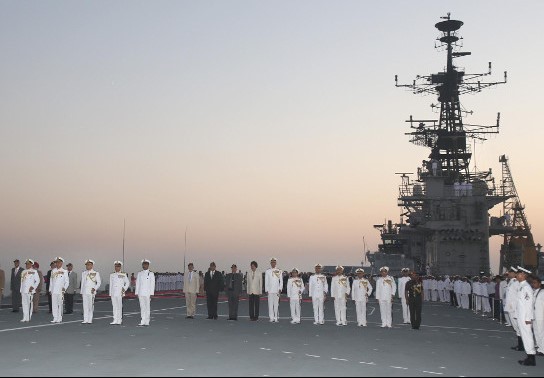
BEIJING (PTI): China has hiked its military spending by seven per cent to US$ 152 billion, about three times higher than that of India, as Beijing braced for countering America's push into the disputed South China Sea.
After skipping the customary mention of the figures of defence spending in the work report submitted by Chinese Premier Li Keqiang to lawmakers on Sunday, state-run Xinhua news agency on Monday announced that the military budget for this year stands at 1.04 trillion yuan (US$ 152 billion).
China's defence budget for 2017 will grow seven per cent from the actual figure in 2016, Xinhua quoted an official with Ministry of Finance as saying on Monday.
"The country's military spending this year will stand at 1.04 trillion yuan (about US$ 152 billion) with 1.02 trillion yuan from the central budget," the Xinhua report said.
This is the first time that China's military spending crossed a trillion yuan.
Last year China's military spending was 954.35 billion yuan, a 7.6 per cent increase from 2015.
China's defence budget is about three times higher than India's US$ 53.5 billion.
There was no explanation about why the amount of the annual defence spending was not mentioned in Li's annual work report to the National People's Congress (NPC) on Monday.
On March 4, NPC spokesperson Fu Ying said China's defence budget will be increased by seven per cent accounting for 1.3 per cent of the country's GDP, compared with NATO members' pledge to dedicate at least two per cent of GDP to defence.
"You should ask them what their intentions are," Fu told reporters, adding that China has "never inflicted harm on other countries."
Chinese officials defended the seven per cent hike this year, saying it is still smaller than the 10 per cent increase proposed by President Donald Trump to America's defence budget to take it to about USD 654 billion, the highest in the world.
Much of China's budget this year is expected to go for the development of Navy as Beijing looks to expand its influence beyond its shores.
China currently has one aircraft carrier and is building another with a third in the planning stage to match the growing strength of the US navy in hot-spots like the South China Sea.
The China-US military tensions are on the rise since former American President Barack Obama adopted the 'US pivot to Asia', committing large number of US military forces to be deployed in the Asia Pacific to counter China's growing military might.
After his election, Trump has sent an aircraft carrier to the South China Sea to assert the freedom of navigation in the area claimed by China.
Vietnam, the Philippines, Malaysia, Brunei and Taiwan have counter claim over the South China Sea.
China's military experts say much of the defence expenditure will go for the Navy to safeguard the country's fast expanding overseas interests and is a response to the unstable security situation in the Asia-Pacific region.
Chu Yin, associate professor at the University of International Relations, said, China's rapid military development is a recurrent trend with the country's rising economic power and is entirely legitimate and reasonable.
"It doesn't need Trump as an excuse," he told state-run Global Times earlier.
"How can China protect millions of overseas Chinese and huge amounts of overseas investment and projects worth billions of US dollars without a powerful navy?" Chu asked.
As per China National Tourism Administration figures, since 2015, Chinese citizens made more than 120 million overseas trips annually.
Additionally, China is currently the world's largest trading nation, so the country is heavily reliant on free trade, and the world also needs to trade with China, Chu said.
Quoting China National Radio, the Global Times report said China's overseas investment in 2016 has reached US$ 221 billion, surging 246 per cent compared with 2015.
"So the Chinese navy has to gain enough ability to protect those key trade routes around the globe," Chu said.
Song Zhongping, a military expert who used to serve in the Second Artillery Corps (now called the Rocket Force) said, "Honestly, the Chinese military hasn't met some of those standards yet, and that's why we have military reform and the budget for national defence will continue to rise."
"For example, the 21st Century Maritime Silk Road, as part of the 'One Belt and One Road' initiative, requires a large and advanced navy, because this 'Road' covers the Pacific Ocean, Indian Ocean and the Mediterranean," Song said.
Yin Zhuo, a rear admiral and a senior researcher at the PLA Navy Equipment Research Centre told China Central Television that in order to protect China's sovereignty and national interests, the PLA Navy at least needs five to six aircraft carriers to maintain presence in specific regions.
An anonymous PLA Air Force officer told the Global Times, "due to 'the US pivot to Asia' strategy since the Obama era, the possibility of military conflict is increasing in the Asia-Pacific region, including the Korean Peninsula, Taiwan Straits, and East and South China seas, so there is no reason for us not to increase the defence budget".
 Previous Article
Previous Article












The Indian Air Force, in its flight trials evaluation report submitted before the Defence Ministry l..
view articleAn insight into the Medium Multi-Role Combat Aircraft competition...
view articleSky enthusiasts can now spot the International Space Station (ISS) commanded by Indian-American astr..
view article